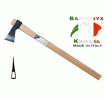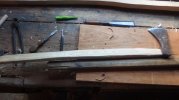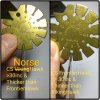What are different axe head shapes good for?
To begin answering this question a good place to start would be:Where have these shapes come From,originally?
Where did CS find these shapes to peddle,what was the reason such shapes were produced by those that Surely had a practical reason to go through all that trouble of forging and hafting it,and offering it for sale to some population that must've had some use for it?
In that photo above,the top one has the shape that I,personally,can only track back in history to something like a Boarding axe.
A shipboard tool built to slice through rigging in an emergency,to clear wreckage and other general demolition chores,(not an accident that these are related to the later fireman axes).
That is why the blade is so wide,and fan-shaped,it's a rope-cutting tool primarily. That's why it's poll-less,it doesn't take much mass to slice in principle,but a thin wide blade.
So not an "axe" in any conventional wood-working sense.
The second one stems directly from Iberian peninsula and the Bay of Biscay,therefore known as Biscay pattern.
It's a tool made for the maintenance of orchards and vineyards,a light hatchet for smaller branches and brush and an occasional smallish tree.
This one is also unencumbered by any added mass at poll,the nature of it's duty also being on the lighter side.
Similarly with other patterns,the first step is to try to trace them to their country of origin and the time period,to hopefully find out what were they originally meant for.
Later,some tools may've became trade items,and were taken to other places where possibly their use was altered,based on the local needs and requirements.
eventually for some tools the origins may've become obscured,or lost all together.
But that's rare,as any useful shape in history has given an incentive to copy it,or to re-invent it in other location,so Some info is most often available.







